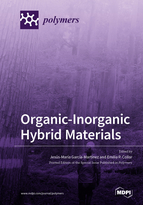Organic-Inorganic Hybrid Materials
A special issue of Polymers (ISSN 2073-4360). This special issue belongs to the section "Polymer Chemistry".
Deadline for manuscript submissions: closed (25 October 2020) | Viewed by 36541
Special Issue Editors
Interests: polymers and environment; heterogeneous materials based on polymers; polyolefins; interfacial agents; interphase; interface; functionalization; plastic wastes; blends; composites
Special Issues, Collections and Topics in MDPI journals
Interests: polymers and environment; heterogeneous materials based on polymers; polyolefins; interfacial agents; interphase; interface; functionalization; plastic wastes; blends; composites
Special Issues, Collections and Topics in MDPI journals
Special Issue Information
Dear Colleagues,
This Special Issue is devoted to one of the most attractive fields in material science and technology research. The concept of organic–inorganic hybrid materials can be applied to a wide variety of approaches at present, including those considering the matrix of inorganic or organic nature. Hence, the encapsulation of organic functionalities within inorganic matrices obtained by sol–gel processes, the polymerization of organoalkoxyxilanes, and the functionalization of inorganic substances such as micro or nanofillers with organic and/or inorganic molecules able to interact with organic matrixes to provide enhanced properties. In any case, it is the interphase between the components that becomes the critical aspect to consider in research activities with this type of advanced material, thus any effort to enhance and understand these interactions will be key to obtaining these materials with "tailor-made"organized structures at the subsequent nano, meso, micro and macro scales.
Dr. Jesús-María García-Martínez
Dr. Emilia P. Collar
Guest Editors
Keywords
- hybrid inorganic/organic polymer-based materials
- heterogeneous materials based on polymers
- interfaces
- interphase
- functionalization
- sol-gel
- chemical modification
- composites
Related Special Issue
- Organic-Inorganic Hybrid Materials II in Polymers (11 articles)







